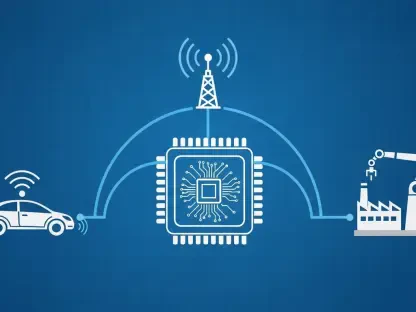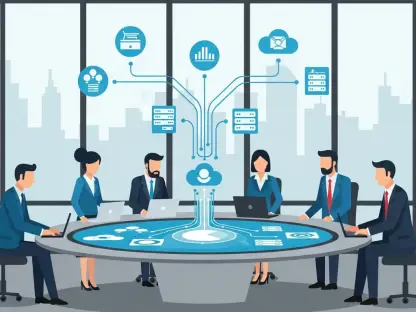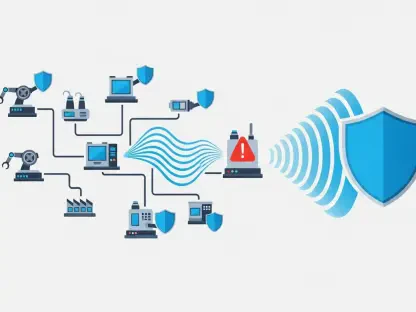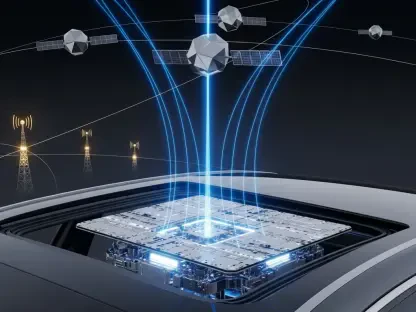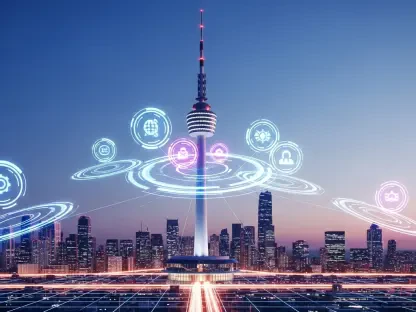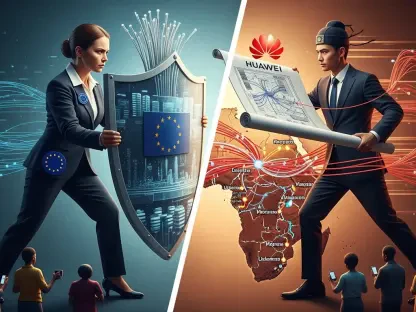In an era where digital connectivity shapes nearly every aspect of life, a transformative technological wave is sweeping across the globe, promising to redefine how societies function, industries operate, and individuals interact with each other in meaningful ways. This wave, driven by the advent of 5G technology, is far more than a simple upgrade from its predecessor, 4G; it represents a seismic shift toward a hyper-connected future where data moves at unprecedented speeds, delays are virtually nonexistent, and millions of devices communicate seamlessly. Imagine a world where a high-definition movie downloads in mere seconds, or a surgeon performs a life-saving procedure from thousands of miles away with flawless precision. This is not a distant dream but a reality unfolding through 5G’s capabilities. Its impact stretches beyond personal convenience, touching the core of economic growth, industrial innovation, and societal progress. As this invisible revolution gains momentum, it becomes clear that 5G is the backbone of tomorrow’s digital ecosystem, enabling everything from smart cities to autonomous vehicles. This exploration delves into the profound implications of 5G, uncovering how it is set to power a world where the boundaries between physical and digital realms are increasingly blurred.
The Technical Marvel Behind Hyper-Connectivity
At the heart of this technological shift lies 5G’s extraordinary capabilities, which set it apart as a cornerstone of the digital age. With speeds up to 100 times faster than 4G, latency as low as 1 millisecond, and the capacity to connect up to 1 million devices per square kilometer, 5G is not merely an enhancement but a foundational leap. These attributes make it the ideal enabler for cutting-edge innovations such as the Internet of Things (IoT), where countless devices—from home appliances to industrial sensors—exchange data in real time. Beyond consumer applications, 5G supports critical advancements like remote surgeries, where split-second responses are vital, and smart city infrastructure, where interconnected systems optimize everything from energy use to public safety. This technology acts as the nervous system of a hyper-connected society, ensuring that data flows instantaneously across diverse platforms and applications, paving the way for a future where responsiveness is no longer a luxury but a standard.
The implications of 5G’s technical prowess extend into realms previously constrained by connectivity limitations. Consider the potential for autonomous vehicles, which rely on near-instantaneous communication to navigate complex environments safely. With 5G, these vehicles can process real-time data from surrounding sensors and other cars, reducing accidents and improving traffic flow. Similarly, in industrial settings, 5G enables the creation of digital twins—virtual replicas of physical assets—that allow for precise monitoring and predictive maintenance. This minimizes downtime and boosts efficiency on a scale previously unimaginable. As these examples illustrate, 5G is not just about speed; it’s about creating an ecosystem where technology integrates seamlessly into everyday operations, breaking down barriers that once hindered progress and opening doors to innovations that reshape entire sectors.
Economic Transformation Through 5G
The economic ramifications of 5G technology are nothing short of staggering, positioning it as a catalyst for global financial growth. Recent estimates value the global 5G market at $156.8 billion in 2024, with projections indicating a surge to $1,584.2 billion by 2035, driven by a compound annual growth rate of 23.4%. This expansion is expected to inject $13.2 trillion into the world economy over the same period, highlighting the technology’s role as a powerhouse of economic activity. Beyond mere monetary figures, 5G is anticipated to generate over 22 million jobs by 2035, spanning sectors from telecommunications to manufacturing. Such projections underscore how this connectivity revolution is not just a tech trend but a fundamental driver of prosperity, fostering innovation, streamlining business models, and creating opportunities on an unprecedented scale.
Moreover, the economic benefits of 5G ripple through various industries, amplifying productivity and unlocking new revenue streams. In manufacturing, for instance, the integration of 5G enables smart factories where machines communicate in real time, optimizing production lines and reducing waste. Retail businesses are leveraging enhanced connectivity to offer immersive shopping experiences through augmented reality, attracting tech-savvy consumers and boosting sales. Even agriculture stands to gain, as 5G-powered sensors monitor soil conditions and weather patterns, enabling precision farming that maximizes yields. These diverse applications demonstrate that 5G’s economic impact transcends traditional tech sectors, permeating every corner of the global market and setting the stage for sustained growth and competitiveness in an increasingly digital world.
Redefining Industries and Societal Norms
Across industries, 5G is sparking a transformation that marks the arrival of Industry 4.0, an era defined by automation and data-driven innovation. In healthcare, the technology facilitates telehealth solutions, allowing doctors to consult with patients in remote locations and even perform surgeries through robotic systems with real-time feedback. Transportation is undergoing a similar overhaul, with autonomous vehicles relying on 5G’s low latency to communicate with each other and infrastructure, enhancing safety and efficiency. Retail and energy sectors are also adapting, using connected systems to personalize customer experiences and manage smart grids for better resource distribution. This widespread industrial shift illustrates how 5G serves as a linchpin for progress, enabling smarter operations and pushing the boundaries of what businesses can achieve in a connected landscape.
On a societal level, the influence of 5G extends far beyond industrial applications, promising to enhance quality of life and bridge longstanding gaps. Access to essential services like education and healthcare is expanding, particularly in underserved regions, as 5G networks support remote learning platforms and telemedicine initiatives. New job categories and business models are emerging, fueled by innovations such as cloud gaming and virtual reality experiences that thrive on high-speed connectivity. As the distinction between online and offline worlds continues to fade, 5G fosters a more inclusive society where digital tools empower individuals and communities. This transformation, while still unfolding, hints at a future where connectivity becomes a universal right, reshaping social interactions and access to opportunities in profound ways.
Competitive Dynamics in the 5G Arena
The race to harness 5G technology has created a fiercely competitive landscape where adaptation determines success. Companies specializing in semiconductors, such as Qualcomm and NVIDIA, are at the forefront, developing the chips that power 5G devices and infrastructure. Infrastructure providers like Ericsson and Nokia are equally critical, building the networks that make widespread connectivity possible. Telecommunications giants, including Verizon and AT&T, are investing heavily to expand coverage, while real estate firms managing wireless towers play a pivotal role in supporting network densification. These players are poised to reap significant rewards, capitalizing on the growing demand for 5G solutions across consumer and industrial markets, and setting benchmarks for innovation in this rapidly evolving field.
However, the competitive arena also reveals stark challenges for those unable to keep pace with 5G’s demands. Businesses clinging to outdated technologies or failing to prioritize cybersecurity risk obsolescence and vulnerability in an environment where data breaches can be catastrophic. The heightened connectivity of 5G, while a strength, amplifies the potential for cyber threats, necessitating robust protective measures. Firms that overlook these risks may lose market share to more agile competitors who embrace the technology and safeguard their operations. This dynamic underscores the high stakes of the 5G revolution, where strategic foresight and investment in both innovation and security are essential for maintaining a competitive edge amid relentless technological advancement.
Charting the Path Forward for Connectivity
As the 5G rollout accelerates, the focus is shifting toward expanding network density in urban centers and extending coverage to rural areas, ensuring that the benefits of hyper-connectivity reach all corners of society. Businesses face the imperative to adapt by investing in compatible technologies and overhauling operational frameworks to manage vast data flows and ensure interoperability. Challenges such as data privacy and security loom large, requiring proactive strategies to protect sensitive information in a more connected world. The path ahead demands collaboration between industries, governments, and tech innovators to address these hurdles, laying the groundwork for a future where 5G’s potential is fully realized through thoughtful planning and execution.
Looking further into the horizon, the long-term vision for 5G encompasses fully autonomous systems and deeply integrated IoT ecosystems that redefine daily life and industrial processes. Success in this endeavor will hinge on sustained investments in infrastructure, such as advanced antennas and fiber optic networks, alongside regulatory frameworks that promote equitable access and innovation. Opportunities abound in areas like edge computing and AI-driven analytics, which can leverage 5G to deliver real-time insights and efficiencies. Navigating this future will require vigilance to balance technological advancement with ethical considerations, ensuring that the hyper-connected world remains secure and inclusive. Reflecting on the strides already made, it’s evident that the journey of 5G began as a bold vision and evolved into a tangible force that reshaped global connectivity standards.


